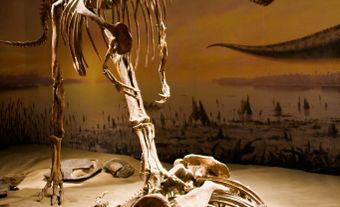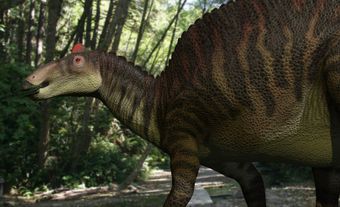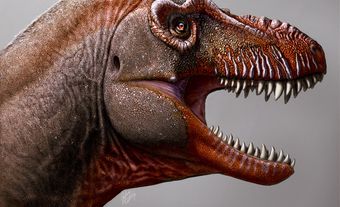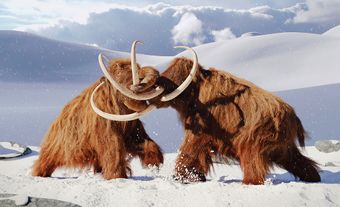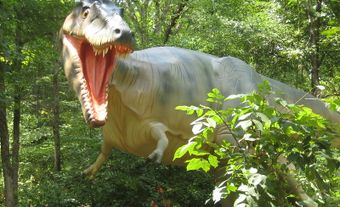Albertonectes (pronounced al-BER-toe-NEK-teez) is a genus of plesiosaur in the family Elasmosauridae. Plesiosaurs were not the same as dinosaurs, though they are sometimes mistakenly placed in the same category. Dinosaurs lived on land, while plesiosaurs were air-breathing reptiles that flourished in the world’s oceans during the same era. Specifically, Albertonectes lived during the Late Cretaceous period (100.5 million–66 million years ago). To date, Albertonectes fossils have only been found in Alberta, south of Lethbridge. Albertonectes had 76 neck bones, the most of any animal.

Description
Albertonectes had a body typical of a plesiosaur, including its long, straight neck and short tail. Its body was also short, as well as broad and stiff, and it had four limbs modified into stiff flippers. As an elasmosaurid plesiosaur, its neck was much longer than the necks of earlier plesiosaurs such as Cryptocleidus from the Middle Jurassic period (174.1 million–145 million years ago). The total length of Albertonectes was 11.2 m, with its 7 m neck being longer than the combined length of its tail and body. The lengthening of the plesiosaur neck was not done by the elongation of the individual neck bones over an evolutionary period, as seen in giraffes, but by the addition of many extra neck bones (cervical vertebrae). In the case of Albertonectes there were 76 cervicals. Despite the great length of the neck, it was very stiff. There was no way it could flex and bend like that of a swan. In a swan, the joints between the neck bones are shaped like interlocking saddles, allowing for side-to-side and up-and-down flexibility. By comparison, the joints between the individual neck bones in Albertonectes were very flat, indicating a limited amount of flexibility. In fact, the Albertonectes fossils discovered in 2007 demonstrate how the stiff neck was. Paleontologists posited that the animal’s carcass had hit the sea bed head first, snapping its neck in three different places as the rest of the body pushed in from behind.
Did you know?
While Albertonectes has the most known neck bones of any animal, that does not mean it has the longest neck. That distinction belongs to Mamenchisaurus, a sauropod dinosaur whose neck reached a length of 12 m. By comparison, Albertonectes’ neck was 7 m. However, in addition to their many neck bones, what distinguished Albertonectes and other Late Cretaceous elasmosaurs from sauropods is that their necks were longer than the combined length of their bodies and tails, giving them their distinctive look.
Plesiosaurs, including Albertonectes, evolved from land-living reptiles during the Late Triassic period (237 million–201.3 million years ago). Much of their anatomy shows their terrestrial ancestry. For example, the same bones found in the arms and legs of land-dwelling reptiles — including five fingers and five toes — were all present in each plesiosaur flipper, hidden beneath the skin. Similar bone structures are found in the flippers of some present-day animals, for example whales and seals, who also had terrestrial ancestors.

Range and Habitat
The only known specimens of Albertonectes come from southwestern Alberta, and date to between 78 to 72 million years old. They were found in the black shale of the Bearpaw Formation. The rocks of the Bearpaw formation record the presence of an inland sea, the Western Interior Seaway, that lay along the eastern flank of the newly developing Rocky Mountains. At its maximum extent, this seaway ranged from the Gulf of Mexico to the Arctic Ocean. It was a true marine environment. In addition to plesiosaurs like Albertonectes, paleontologists have found fossils of giant clams, sea stars, lobsters, ammonites, nautiloids, sharks, bony fishes, sea turtles and mosasaurs. The fossils of Albertonectes were found in rocks deposited far from shore which indicate that it was adapted to living in open water.

Reproduction and Development
With only one near complete specimen, and a few isolated strings of vertebrae from other specimens, paleontologists do not know much about the reproduction and development of Albertonectes based on its fossil record. However, based on its anatomy, it is clear that the animal could never have come ashore. This means females must have given birth to live young at sea, skipping the egg-laying stage of terrestrial reptiles. There is fossil evidence of fetuses developing in the body of a Polycotylus, another Late Cretaceous plesiosaur, providing further evidence that Albertonectes would have undergone the same reproductive process.
Diet
Unfortunately, no one has found an Albertonectes head, so nothing can be said directly about its teeth and jaws, and by inference what it ate. However, all known elasmosaurs had relatively small heads with long, slender teeth. The upper and lower sets of teeth meshed together when the mouth was closed. These small teeth and slender jaws mean that Albertonectes was not attacking and dismembering large prey animals. Instead, it must have gathered small fish and crustaceans from the water column. It may also have collected invertebrates from the sea bed.
Behaviour
Elasmosaurs were very large animals, and large animals are rare in any environment. This implies that Albertonectes were solitary hunters, except during breeding season. A large collection of stomach stones were found in the body cavity of Albertonectes. There are main two theories as to why Albertonectes and other plesiosaurs are often found with stones in their stomachs: for ballast or for digestion. However, both ideas have problems. First, the stones found with plesiosaurs are too small to affect buoyancy. For example, Albertonectes weighed 4.8 tonnes, but only 9 kg of stones were found with the fossil. With respect to the second theory, all plesiosaurs are interpreted to have been strictly carnivorous, but the only living animals that use stomach stones to aid their digestion are plant eaters (for example, birds such as chickens). Paleontologists continue to develop theories as to why plesiosaurs are found with stones in their stomachs.

Discovery and Naming
The remains of Albertonectes were found by accident. For many years the commercial fossil company Korite International has been looking for gem-quality ammonite shells in the Bearpaw Formation south of Lethbridge, Alberta, and using trackhoes for their excavation. Occasionally, they expose a mosasaur — a type of sea-going lizard related to living monitor lizards such as the Komodo dragon. It was a great and welcome surprise to come across the remains of what would eventually be called Albertonectes — an elasmosaur — at the Korite diggings in 2007. The Royal Tyrrell Museum dispatched a team of six staff to collect the remains. The job took them three weeks. The founder of Korite International was a business man named Rene Vanderveld, and the species’ full name, Albertonectes vanderveldei (“Van der Veld’s Alberta swimmer”), honours his efforts on behalf of palaeontology in Canada.

 Share on Facebook
Share on Facebook Share on X
Share on X Share by Email
Share by Email Share on Google Classroom
Share on Google Classroom
